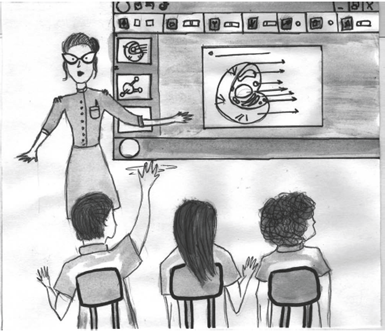The Power Point uses on the teaching and learning experience in the area of natural sciences
DOI:
https://doi.org/10.31908/grafias.v0i27.1323Keywords:
ICT (information and communication technologies), Power Point, new school, teaching and learningAbstract
This article is intended to understand the uses of Power Point as a teaching and learning experience in the area of natural sciences in the 3rd, 4th and 5th grades of the Educational Institution Jorge Isaacs of the municipality of Ansermanuevo. The investigation has in focus the qualitative comprehension, in which we approach the analysis in three categories: The use of ICT as an instrument of mediation between students and the subject matter, ICT as an instrument to mediate between professors and contents (homework) and finally ICT as an instrument to mediate the relationship among professors and students, or between students. The didactic strategy has a socio-constructive character that was taken from the experimental phase of the investigation, in which the professor sustained the work task, involving the technological resources supporting the pedagogical practice and therefore contributes to a significant learning experiences.
References
Adell, J. y Castañeda, L. (2012). Tecnologías emergentes, ¿Pedagogías emergentes? D i s p o n i b l e e n http://digitum.um.es/xmlui/bitstream/10201/29916/1/Adell_Castaneda_emergentes2012. pdf
Coll, C., Mauri, T., Onrubia, J., Solé, I. y Zabala, D. (1997). El constructivismo en el aula. Barcelona: Editorial Graó.
Erickson, F. (1989). Métodos cualitativos de investigación sobre la enseñanza, en: Wittrock, M. (comp.) La investigación de la enseñanza, II. Métodos Cualitativos y de Observación. Barcelona: Paidós.
Estándares básicos de competencias en ciencias naturales (s.f.). Disponible en http://www.mineducacion.gov.co/1621/articles-116042_archivo_pdf3.pdf el 1 de agosto de 2014.
Godoy, R. (2011). Percepción del uso de TIC en las prácticas pedagógicas de los profesores de Educación Especial. Revista Electrónica Educare, XV (2).
González, C. (2012). Aplicación del Constructivismo Social en el Aula. D i s p o n i b l e e n http://www.oei.es/formaciondocente/materiales/OEI/2012_GONZALEZ_ALVAREZ.pdf Levis, D. (2008).
Formación docente en TIC: ¿el huevo o la gallina? Revista: Razón y Palabra, 13(63). Olivera, M. y Niño, R. (2012). Un vistazo a la capacitación en TIC desde las experiencias de los docentes, argumentos. Argumentos, 4. D i s p o n i b l e e n http://revistaargumentos.iep.org.pe/articulos /un-vistazo-a-la-capacitacion-en-tic-desdelas-experiencias-de-los-docentes/
Ortiz, L. (2012). Curso de investigación c u a l i t a t i v a . D i s p o n i b l e e n http://datateca.unad.edu.co/contenidos/4011 22/MODULO_3_Creditos_IC_12.pdf. el 10 de agosto de 2014.
Taylor, R. (1980).: The computer in the school: Tutor, tool, tutee. New York: Teachers College Press.
Wagner, T. (2008). Las siete habilidades de s u p e r v i v e n c i a . D i s p o n i b l e e n http://www.smarteducation.com.co/2014/05/las-siete-habilidades-desupervivencia.html.


